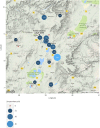Respiratory disease and sero-epidemiology of respiratory pathogens in the working horses of Ethiopia
- PMID: 29574904
- PMCID: PMC6175379
- DOI: 10.1111/evj.12834
Respiratory disease and sero-epidemiology of respiratory pathogens in the working horses of Ethiopia
Abstract
Background: Pathogens are frequently implicated in equine respiratory disease. In Ethiopia, respiratory disease is a frequent cause for presentation at veterinary clinics and a priority concern for users of working horses. However, there is little existing literature on possible aetiologies.
Objectives: Determine prevalence of respiratory signs and exposure to major respiratory pathogens through a serological survey.
Study design: Cross-sectional.
Methods: Systematically selected horses from 19 sites in central Ethiopia were examined clinically and sampled once (August-December 2013). A face-to-face interview collected data on horses' management and history. Serological testing targeted equine influenza virus (EIV), equine herpesviruses-1 (EHV-1) and -4 (EHV-4), equine rhinitis viruses A (ERAV) and B (ERBV), equine arteritis virus (EAV) and Streptococcus equi subspecies equi (S. equi).
Results: Owners reported a recent history of coughing in 38% of horses and nasal discharge in 7%. No animals were observed coughing during examination but 6% had a nasal discharge. Antibodies towards S. equi, were most prevalent (8%, 33/350). Antibodies to EAV were confirmed in one animal (0.3%). Low antibody titres to EHV-1/4 and ERA/BV suggested prior exposure but antibodies to EIV were not detected. Multivariable, multilevel logistic regression analysis for risk factors associated with S. equi serostatus showed higher odds of seropositivity in younger animals and those working less frequently.
Main limitations: A single serological sample cannot describe dynamic changes in antibodies. Sampling horses at the place of work may result in healthy-worker bias.
Conclusions: S. equi may be endemic in this population and contributing, in part, to the occurrence of respiratory disease. Low prevalence of antibodies to viruses, with the exception of EIV, indicates these pathogens are present, but unlikely a predominant cause of respiratory signs and noninfectious causes of disease should also be investigated. Working horses in this region would be vulnerable to incursion of equine influenza.
Keywords: ELISA; Streptococcus equi; Africa; horse; prevalence; serology; strangles.
© 2018 The Authors. Equine Veterinary Journal published by John Wiley & Sons Ltd on behalf of EVJ Ltd.
Figures


References
-
- FAOSTAT . (2014) FAOSTAT, Food and agriculture organization of the United Nations. Rome, Italy.
-
- Admassu, B. and Shiferaw, Y. (2011) The Brooke: donkeys, horses and mules – their contribution to people's livelihoods in Ethiopia. The Brooke Report.
-
- Holcombe, S.J. , Robinson, N.E. , Derksen, F. , Bertold, B. , Genovese, R. , Miller, R. , de Feiter Rupp, H. , Carr, E.A. , Eberhart, S.W. , Boruta, D. and Kaneene, J.B. (2006) Effect of tracheal mucus and tracheal cytology on racing performance in Thoroughbred racehorses. Equine Vet. J. 38, 300–304. - PubMed
-
- Bailey, C.J. , Rose, R.J. , Reid, S.W. and Hodgson, D.R. (1997) Wastage in the Australian thoroughbred racing industry: a survey of Sydney trainers. Aust. Vet. J. 75, 64–66. - PubMed
MeSH terms
Substances
Grants and funding
LinkOut - more resources
Full Text Sources
Other Literature Sources
Molecular Biology Databases

